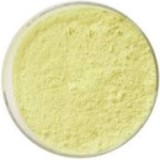 |
Sodium Feredetate or Ferric Sodium EDTA BP Ph Eur Grade Supplier Exporter Manufacturers' Representative |
Email: info@ammol.org |
Call Toll Free +1-855-552-6665 |
Sodium Feredetate or Ferric Sodium EDTA
CAS Number: 15708-41-5
Molecular Formula: C10H12FeN2NaO8
Molecular Weight: 367.05

Sodium Feredetate or Ferric Sodium EDTA
Sodium Feredetate or Ferric Sodium EDTA is not found in USP monograph.
Sodium Feredetate BP Ph Eur Grade Specifications
C10H21N2O8FeNa,H2O -- 385.1 -- CAS 15708-41-5
DEFINITION
Sodium Feredetate is iron(III) sodium ethylenediaminetetra-acetate monohydrate. It contains not less than 98.0% and not more than 102.0% of C10H12O8N2FeNa, calculated with reference to the dried substance.
CHARACTERISTICS
A yellow or yellowish brown, crystalline powder; hygroscopic.
IDENTIFICATION
A. The infrared absorption spectrum is concordant with the reference spectrum of sodium feredetate.
B. Ignite 0.5 g and allow to cool. Dissolve the residue in 2 ml of hydrochloric acid , add sufficient water to produce 20 ml and filter. The filtrate yields reaction C characteristic of iron salts. Dilute 1 volume of the filtrate to 10 volumes with water; the solution yields reaction B characteristic of iron salts.
C. Dissolve 2 g in 30 ml of water, slowly add 6.5 ml of a 20% w/v solution of potassium hydroxide, shake and filter the resulting suspension. Evaporate 8 ml of the filtrate to dryness, ignite and dissolve the residue in 4 ml of water. The solution yields reaction B characteristic of sodium salts.
TESTS
Acidity: pH of a 1% w/v solution, 4.0 to 6.5.
Free iron: Not more than 500 ppm when determined by the following method.
Dissolve 0.2 g in sufficient water to produce 20 ml and filter. Label three tubes A, B and C. Place 5 ml of the filtrate into each of tubes A and B and 4 ml of water and 1 ml of an iron standard solution prepared in the following manner in tube C. For the iron standard solution dilute 25 volumes of a 0.1726% w/v solution of ammonium iron(III) sulphate in 0.05M sulphuric acid to 200 volumes with water (25 ppm of Fe(III)). Add 1 ml of a 1.0% w/v solution of disodium catechol-3,5-disulphonate into each of tubes A and C and 1 ml of water to tube B. Measure the absorbance of solution A at 670 nm using solution B in the reference cell and of solution C using water in the reference cell. The absorbance of solution A is not greater than that of solution C.
Heavy metals: 1 g complies with limit test D for heavy metals 20 ppm.
Free sodium EDTA: To 4 ml of a 1.0% w/v solution add 2 ml of ferric iron standard solution (50 ppm) and 1 ml of a 1.0% w/v solution of disodium catechol-3,5-disulphonate and mix. Prepare a standard in the same manner using 4 ml of a 0.010% w/v solution of disodium EDTA in place of the solution of the substance being examined. Measure the absorbance of the solutions at 670 nm using water in the reference cell. The absorbance of the solution of the substance being examined is not less than that of the standard solution (1%).
Sulphates: Dissolve 2 g in 40 ml of water, add 5 ml of a 20% w/v solution of sodium hydroxide and sufficient water to produce 50 ml, shake and filter. Evaporate 6.2 ml of this solution to drynessand ignite until no trace of carbon remains. Cool and dissolve the residue in 10 ml of distilled water. Neutralise the solution with 2M hydrochloric acid using litmus paper as external indicator and add 2 ml in excess. Boil the solution, cool, dilute to 15 ml with distilled water and filter. The filtrate complies with the limit test for sulphates 600 ppm.
Loss on drying: When dried over silica gel at 120C at a pressure not exceeding 2 kPa for 5 hours, loses 4.0 to 13.5% of its weight. Use 1 g.
Please visit SDS Safety Data Sheet of Sodium Feredetate or Ferric Sodium EDTA Suppliers.
American Molecules, also known as ammol.org is a distributor, supplier and manufacturers' representative of all types of Pharmaceuticals, Functional Ingredients, Excipients and Specialty Chemicals in Texas USA. Our principals manufacture supply and export USP NF BP, Ph Eur, etc grades of chemicals pure and reagent grade, mineral fortifiers, FCC food grade. Tailor made particle size and customized specifications are offered. The principal's facility is having one or more of the certifications like FDA approval and GLP, cGMP, ISO9001, ISO14001, ISO/IEC 17025, ISO22000, FSSC 22000, ISO45001, FSSAI, Kosher, HALAL, COPP, WHO-GMP certified and Written Confirmation (WC) for export to Europe is available. The manufacturers suppliers and exporters observe WHO Good Manufacturing Practices and Good Laboratory Practices.





Suppliers and Manufacturers' Representative:

9910 Bent Oak Dr
Houston, TX 77040, USA
Call Toll Free: 1-855-55-AMMOL 1-855-552-6665
Email: info@ammol.org